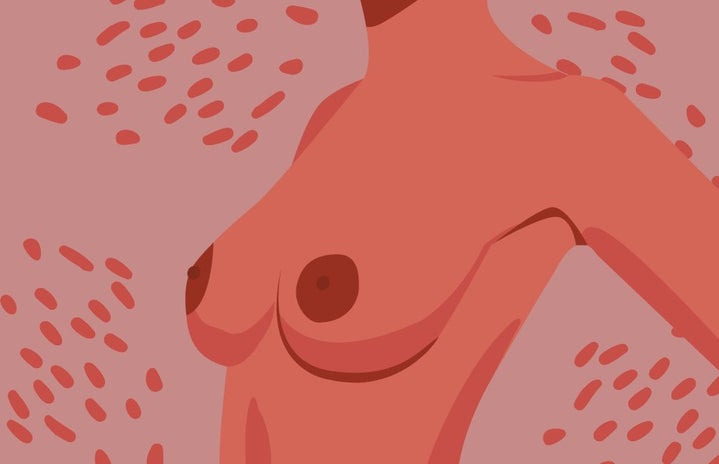Walking down the street, choosing a T-shirt to wear during the day, and posting a photo on social media – these all seem like commonplace actions that are beyond judgment. However, if you’re a woman, the scenario changes, as they can all become nightmares if your nipples are showing.
The controversy surrounding female nipples is growing due to a growing awareness of gender equality and the sexualization of the female body. Many people question why they are often considered offensive or obscene in comparison to male nipples, raising concerns about the objectification of women and censorship on social media. In addition, artists, activists, and women’s rights advocates argue that the ban on female nipples contributes to the perpetuation of unrealistic and harmful beauty norms.
As the dialogue around these issues grows, the female nipple controversy becomes a symbol of the ongoing struggles for gender equality and acceptance of the female body in all its diversity.
THE ORIGIN OF THE CONTROVERSY
Historically, the difference in the normalization of exposing male and female nipples can be traced back to a complex network of cultural, social, and historical factors. In many societies, male nudity was associated with strength, virility, and power, while female nudity was often stigmatized and controlled due to ideas about modesty, purity, and submission. The objectification of the female body also played a significant role, where women’s breasts were often seen as sexual objects rather than natural body parts.
The influence of religion, social norms, and male hegemony in culture contributed to this disparity. Even today, these historical norms persist in many societies, although there is a growing movement to challenge these conventions and promote gender equality.
For many years, showing female nipples was considered an offense. Strict standards of modesty and modesty were generally imposed on women, and the nakedness of the breasts was often associated with sexuality and desire, which could be considered inappropriate or threatening to public morality. In some cultures, women were obliged to cover their breasts in public as part of a strict dress code that reflected social expectations of female purity and submission. These historical norms often restricted women’s freedom to express their bodies naturally and contributed to the misconception that female nipples were intrinsically obscene or unacceptable for public display.
BRA: FRIEND OR ENEMY?
The bra, although designed to provide women with support and comfort, has often been criticized as a step backward in the process of fighting for the freedom of the female nipple. Its history is deeply rooted in the culture of repression of the female body. Since the beginning of the 20th century, the bra has been promoted as a garment that would shape and conceal the breasts, following standards of beauty and modesty imposed by society.
Over the decades, this garment ended up contributing to the sexualization and objectification of breasts, while at the same time preventing women from feeling free to display their nipples freely. This not only reinforced restrictive gender norms, but also perpetuated the idea that female nipples are intrinsically obscene, undermining efforts towards gender equality and the acceptance of the female body in its natural form.
In addition, the continued use of the bra has also raised health concerns, with studies suggesting that it can contribute to postural and circulation problems. As more women begin to question the need for the bra and seek the freedom to choose when to wear it or not, this garment becomes a focal point in discussions about women’s autonomy over their own bodies and the redefinition of beauty and fashion norms in a context of gender equality.
IMPACTs ON EVERYDAY LIFE
The controversy surrounding female nipples has a significant impact on women’s daily lives, covering various aspects of their lives. Firstly, it influences their clothing choices. Many women feel pressure to conform to social norms that restrict the exposure of female nipples, leading them to select clothing that hides this part of their bodies. This limits freedom of personal expression and the ability to choose clothes based on comfort and style, perpetuating the idea that women’s appearance should be rigidly controlled.
It’s important to note that the issue of female nipples can have implications for the job market. Women who speak out against clothing norms can face discrimination or judgment, which can affect their professional opportunities. The objectification of female bodies and expectations related to dress can undermine gender equality in the workplace, making it harder for women to be taken seriously and respected for their skills and competencies.
Another point concerns situations of harassment, where the hypersexualization of women’s breasts contributes to a culture of harassment and misogyny. Women can be victims of unsolicited comments, looks, or touches that result from the erroneous perception that women’s nipples are objects of public desire, making their daily lives potentially uncomfortable and damaging their psychological and emotional well-being. Therefore, the controversy surrounding female nipples has profound and multifaceted implications for women’s lives, influencing everything from their clothing choices to their experience in the job market and their safety in situations of harassment.
CENSORSHIP OF SOCIAL MEDIA
The “Free the Nipple” movement is a gender equality campaign that defends women’s freedom to expose their nipples in public in the same way as men. Starting in the early 2010s, it has gained prominence as a form of protest against the social and legal restrictions that differentiate between male and female breast exposure. The movement seeks to challenge the sexualization of women’s breasts, highlighting the hypocrisy of norms that allow men to show their nipples in public while women face censorship and discrimination for doing the same.
The movement’s importance lies in its ability to draw attention to wider issues of gender equality and women’s rights. It highlights how cultural and legal norms often perpetuate harmful gender stereotypes and limit women’s freedom in relation to their own bodies. In addition, the movement serves as a catalyst for discussions about sexual objectification, beauty standards, and the need to promote a more inclusive and equal society.
Although it has faced challenges and resistance in some places, the “Free the Nipple” movement has had a lasting impact, generating discussion and awareness about issues of gender equality and women’s rights around the world. It continues to inspire activists to fight for changes in censorship policies and to question the gender norms that still persist in contemporary society.
IS THERE A SOLUTION?
The current state of the female nipple controversy varies according to region and culture, but there are signs of change underway. In some places, there have been advances in the acceptance of female nipple exposure, as discussions about gender equality and bodily freedom continue to gain prominence.
Movements such as “Free the Nipple” and the growing awareness of the hypersexualization of the female body have contributed to greater acceptance of exposing women’s breasts in public, especially in contexts such as breastfeeding and art. However, social norms and censorship policies on social media platforms still impose restrictions on the freedom of female nipples, which highlights the continued need to challenge these conventions.
There is therefore hope that the situation could improve further as more people become aware of the importance of gender equality, acceptance of the female body, and the fight against objectification. Education, awareness-raising, and activism play a key role in changing cultural and political norms, and the growing support for movements promoting gender equality suggests that society is moving in the right direction.
However, change will take time and continuous effort, as entrenched norms and gender inequalities are not easily overcome. With the persistence of activists and defenders of women’s rights, there is hope that restrictions around female nipples can continue to diminish and that a more equal and inclusive environment can be achieved.
————————–
The article above was edited by Clarissa Palácio.
Did you like this type of content? Check Her Campus Cásper Líbero‘s home page for more!


